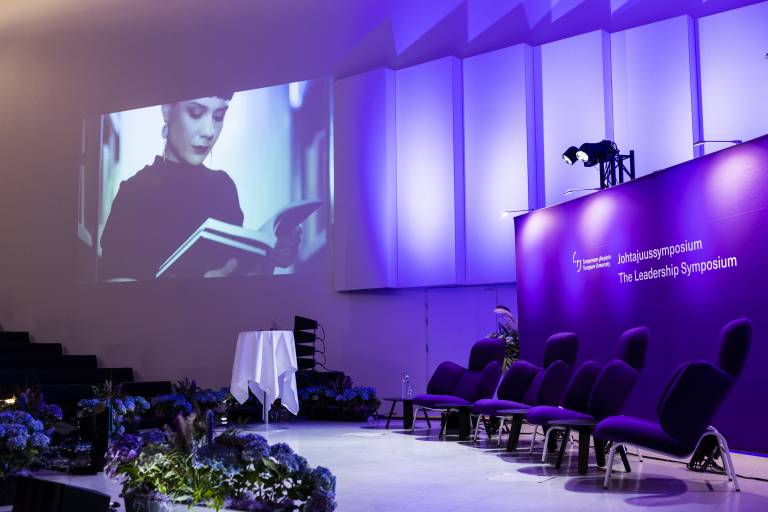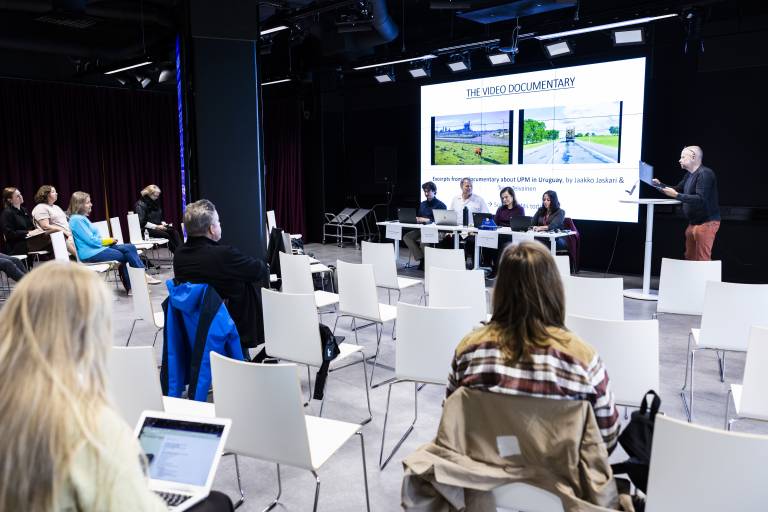1. Jobs exist but where to find labour: Action plan for answering the needs of the battery sector
Aleksi Alanko, Paavali Koivula, Bohui Lian, Antti Kinnunen and Joona Tornberg
The transition to renewable energy sources in transportation requires efficient utilization of battery technologies in electric vehicles (EV). As a result, considerable amounts of new jobs will be created globally around battery technologies. Finland’s expertise in the field of technological solutions provides a potential for it to become a prominent global player in the battery industry. Currently, the region of Salo in South-West Finland has become the strongest concentration for national battery expertise. Salo is known for its legacy in manufacturing televisions and Nokia’s mobile phones, and its prospects today in the battery sector are significant.
The research aimed to identify drivers and barriers for the creation of jobs in the battery sector of Salo. Additionally, the concept of a sustainable job was examined. The research questions were: 1) What are the drivers and barriers of job creation in the Salo battery cluster? 2) What does a sustainable job mean in this context? Although the shift to renewable energy sources in transportation is considered sustainable, how the transition is done is also crucial. Especially the role of skilled employees and human capital in the battery sector is essential, as the battery industry requires new types of expertise and skills. The research utilized data from three semi-structured interviews with key stakeholders in Salo’s battery sector. Additionally, Finland’s National Battery Strategy 2025 was analysed.
The study suggests that the global boost in the EV industry and the market demand for batteries in itself acts as a clear driver for job creation in Salo. Global demand pushes companies to increase their volumes of battery production and Finnish companies have invested in battery production in Salo region. Although the current focus is on the end-products of the value chain, other applications and services, including circular economy solutions, could provide more chances for employment in the future. When support from the government, local willingness and knowledge on technology clustering, and the Finnish companies’ utilization of the market demands are successfully combined and applied, the prospects of Salo in terms of job creation, especially in a 5 to 10 -year time range, are promising.
The greatest barrier is not about the ability of companies to offer jobs, but rather about the lack of skilled labour, which may deter companies from investing in their production in Salo in the future. Lack of coordination between actors can also be seen as a hindrance to the current potential and efficient utilization that requires joint efforts from the public, private, and research actors. Another possible barrier is Salo’s remote location concerning the global markets. This can be a challenge in terms of costly logistics, remoteness to other parts of the battery value chain, and distance to user markets. Additionally, rapid market changes, the constant development of new technologies, and the impacts of both national and EU-level subsidies and support mechanisms cannot be predicted and thus, estimating job creation in Salo in the longer time range is difficult, yet optimistic.
Due to shifting markets, labour demands may change rapidly. This puts stress on both the social and economic sustainability of the battery industry. The unpredictability of market demands creates challenges for companies to act sustainably. As new innovations impact the value and production chains and the skills that are needed, the sector needs to be agile in reactions but also proactively monitor the market. Based on the findings the students emphasize investing in human capital in terms of boosting expertise through training that adapts to changing market demands flexibly and attractiveness through competitive salary, work conditions and supporting employees’ relocation to Salo. In addition, employees’ long-term employment should be guaranteed whilst minding adequate professional development.
Innovation in the sector should be supported by complementary basic and applied research by local educational institutions. Additionally, the students encourage well-executed coordination and guidance from public sector actors in order to utilize the diverse stakeholders and create synergies for economic growth and the creation of jobs. Additionally, it is important that the national and local governments continue to support the agility of Finnish companies in Salo and diverse business opportunities, including circular economy solutions. It was outside the reach of the study to investigate the ecological sustainability of the value chain in battery production, and further study could be conducted solely on the ecological sustainability. In addition, a study on the biggest private actor, Valmet Automotive in their ability to create jobs in Salo, would be recommended.
2. Inconsistent monitoring of fair living wages in consumer electronics industry
Mari Issakainen, Janette Kiemunki, Mikaela Lindfors, Nelli Lius, Ida Takala and Annika Vaara
The production and consumption of consumer electronics being so extensive, sector’s wage problems are also widely visible and touch the daily lives of millions of employees. Globally about 327 million employees make minimum wage or less. This number is 19 % of all wage earners. In total, 266 million people are paid less than what the minimum wage is for an hour. This is mainly due to the companies not complying with regulations or the law.
The aim of the research was to find ways to verify sufficient living wage levels of companies in consumer electronics supply chains and especially production part. The study was carried out by comparing companies within the electronics sector that have reported monitoring workers‘ wage levels in their supply chains.
The research question is:
How can companies ensure living wages in the production part of their supply chain?
The study was carried out by benchmarking the largest European companies within the electronics sector that have reported monitoring workers’ wage levels in their supply chains. After selecting the companies, the students reviewed thoroughly their websites and read through the latest available reports. Terms ‘living wage’ and ‘human rights’ were searched from the material, and the context of these terms was analyzed.
The findings show that the reporting of the fair living wage monitoring varied between companies. Companies were not prepared to determine an adequate wage level themselves, but the adequacy of wage levels is entirely based on local legislation. The main tools for supply chain monitoring were identified as conducting various annual surveys for the suppliers, on-site visits and blocking of suppliers in the event of Code of Conduct violations. Many of the companies included fair wage levels as part of supply chain management, but it was not specified how this matter was tracked or monitored. Based on the research, fair living wage monitoring within the supply chains is still in its infancy in many respects, and the reporting is limited, and its transparency could be improved.
3. Social Media Influencers, Youth, and Greenwashing: a case study of young consumers in Finland
Laura Markkanen, Iiris Korhonen, Robert Stewart, Tuuli Toivonen and Laura Vakkila
Young people are, on average, more active on social media platforms (Scott et al., 2017), and most Finnish influencers are young people, with followers often younger (Koskinen, 2008). Similarly, the EU law identifies the youth demographic as vulnerable (European Commission, 2016). Therefore, this study explored social media influencer marketing in Finland concerning greenwashing, regulation, and young people. The research asked (1) how does the Finland youth audience view the role of social media influencers on greenwashing and sustainable consumption habits, and (2) how could social media influencers be better regulated to avoid greenwashing? An online survey was utilized for data collection, including open questions, which were analyzed by the thematic analysis approach. The online survey reached 34 respondents, mainly Finnish speakers and several English speakers. There were 144 responses across seven open questions resulting in 94 codes, 18 categories, and six themes. The emergent themes were as follows: 1) The consumers, 2) Responsibility of companies, influencers, and platforms, 3) Substantiation structures, 4) Company-consumer information communications, 5) Law & policy, and 6) Educational youth outreach. The results show that the dissemination of false information and greenwashing is a negative phenomenon for social media influencers and associated companies. Further, conveying false information is reprehensible and thought to be due to the influencer’s lack of knowledge about the service or product rather than the purposeful action (i.e., action to the suspicion of greenwashing seems soft). Many of the respondents also expressed a clear desire for regulation of sustainability influencers, such as through standard criteria and required certifications, to deter and recognize any false sustainability claims made by them. Notwithstanding, these findings should be generalized cautiously due to the sample size and Finnish context. Finally, future research could look at how social media influencers could better promote responsible consumption habits. Additionally, how and where it is possible to most effectively influence the audience who wants more information about environmentally friendly consumption patterns.
4. Cooperation and redefining in the changing operational environment: Case Study on the Industrial Union as Promoter of the Seasonal Workers’ Rights
Emma Åkerman, Heidi Helo, Hyeseong Kim, Petri Lepistö, Saara Hildén and Wilma Makkonen
As more and more nations rely on seasonal workers to collect the harvests, seasonal worker’s rights have become a global issue. The use of seasonal workers in agriculture is common in many countries, accompanied with the violations of worker’s rights. Seasonal workers arriving in Finland come from several countries, although the majority comes from Ukraine. The descriptive case study analyses the steps and measures taken by the Industrial Union regarding the rights of the seasonal workers. The research aims is to bring forth the possible issues and deficiencies in the Union’s role in promoting seasonal workers’ rights and offer possible suggestions.
The students have used the qualitative research method which contains semi-constructed interviews with open-ended questions with three workers in the different levels of the Industrial Union. The students have also used content analysis by compiling and going through selected documents in Finnish and in English relevant to the case. The legal framework in which the seasonal worker’s rights are operated consists of the EU and national law. The European Parliament and the Council of the European Union Seasonal Workers Directive of 2014 defines seasonal workers as third-country nationals.
The central focus of the interviews the students have conducted was to determine and collect the main features that seasonal workers experience during their residency in Finland. The interviews have highlighted that lack of information, membership and cultural differences were the main concerns among the union workers. Unable to contact the Union or other respected authorities, seasonal workers are deprived of the opportunity to understand the functions of the Union. The document analysis has revealed that these issues concerning the rights of the seasonal workers have been continued at least for a decade. It became clear that foreign seasonal worker’s do not enjoy the rights at the same level as Finns. The language barriers and unwillingness of seasonal workers to bring negative issues to public out of fear of losing jobs is the key issue. The employees of the Union the students have interviewed were aware of these issues.
The seasonal workers’ rights should not be understood as a separate issue but with its relation to other phenomena, such as the complexity of the operational environment and fragmentation of working life. The future vision is the Union playing a more active and engaging role regarding the seasonal worker’s rights. Expanding the Union’s image beyond being the voice of big industrial units is required. The case study also noted that the Union should also overcome being highly dependent on external factors. Overall, the seasonal workers ought to be more aware of their rights and belonging to the Union, which should be made accessible for them.
5. Activism on sustainability
Tiia Tuovinen, Mika Langel, Susanna Holma and Yahya Sonko
Young adults are more likely to change their consumption behaviour when activist tactics are non-disruptive
Activism aims to defeat a damaging dominant paradigm and replace it with a better alternative. It is usually done by targeting a business or government and aggressively impeding their activities through boycotts, rallies, petitions, or even destroying their facilities or equipment. There is, however, another side to the narrative, which involves raising awareness among those who use products or services that may have major sustainability difficulties hidden behind the scenes. As a result, the research focuses on the effectiveness of activist tactics used to change the narrative in the fast fashion industry.
All the participants were aged 18 and above at the beginning of the study period from 17.09.2021. In order to understand how activisms´ actions impacted fast fashion industry, a series of statistical procedure was performed. Also, a number of techniques have been developed to collect data from the respondents. First, the students have approached and collected answers from at least ten participants from the shopping center in Tampere more precisely from Ratina shopping center. Second, the students have sent the same questions over the internet and got 50 responses.
Afterward, as there are currently several methods for measuring public opinion. The students did, however, employ both qualitative and quantitative approaches. The study employs quantitative analysis to gain insights into numerical values of how much or how little the relationship stands. In addition, in the case of the study, the students use numerical data to support or refute some of the theories associated with activism in the fast fashion industry. To compare the relationships between the variables, the students screened the data first, then used both linear regression and the pairwise test correlational test. Four segments were extracted for study and utilized as dependent variables from data as proxies for the hypothesis. The qualitative approach was content analysis, particularly with the open-ended question. The advantage of this combined approach is that they cover each other’s blind spots as the students drive to a conclusion. The selected mixed technique allows us to investigate both the replies of the respondents and the findings that link the literature.
Finally, due to the obvious limited sample size of 60 responses, the findings are not generalizable. However, there are several advantages to be gained from this research. First, the students discussed how successful some of the more visible activist efforts are. In this instance, activists will know where to focus the future efforts. Second, the study identified disruptive behaviours that may be avoided. Third, the students have included age and gender groupings and their perceptions, which might be useful when targeting certain age groups for activism.
6. Collaborative strategy making
Vilma Kivinen, Isabel Rangel, Tuukka Tulosmaa, Mashiur Rahman and Yulia Gulyaeva
Research problem and its justification
The case association was a small horseback archery association from Finland. It was interested getting to know how an association can grow its operations, involve more key stakeholders in its work, create a long-term strategy for growth, improve stakeholder engagement, and how to get opportunities to acquire funding. The association would like to grow its strategy along with sustainability guidelines to support wider sustainable development growth.
Methodology
The methods used were qualitative research design, which included qualitative focus group discussion and an online survey distributed to association members. The survey aimed to gather interviewees’ opinions and concerns regarding topics of how the association has been working so far, what were things that could be improved from the participants’ points of view. The focus groups and survey questions included topics about sustainability, stakeholder engagement, finances, and ways to move forwards. The research questions were, for instance, “How would the key stakeholders be willing to contribute to the association’s activities and planning and/or implementation of a long-term strategy?”, “How can the association’s long-term strategy help them to achieve economic sustainability?”, and “What elements the association could include in their long-term strategy?”.
Significance of findings for a larger audience
The findings indicate that stakeholder engagement is a rather difficult and time-consuming process. The case association represents a rather unique sport and may need more effort to get bigger visibility. In total, out of approximately 200 members of the case association, only 21 members willingly participated in this study. Of them, many drew examples of how the association was succeeding so far, yet they as well gave views on issues that could be improved. One of them concerns engagement, as participants clearly wanted to have more “volunteering in events for members and the general public, volunteering in competitions, training.” The other aspect concerning willingness to have more and better communication, for example, postings on social media. For their strategy, the association could 1. make a financial plan that includes short-term and long-term objectives with methods to achieve these objectives, 2. Focus on topics that members consider important, these include activities to support engagement, as more events for members, development programs for trainers’ path, communication and visibility, clearer and more transparent ways of working, more focus on horses and animal welfare, safety guides. 3. a strategic plan of expansion, identifying the most relevant stakeholders for expansion and creating a plan by collaborating and engaging them.
A strategy would need to include financial planning for securing, for example, governmental funding for association. A clear long-term strategy can guide associations in terms of direction, improved governance, and help the association to focus on its long-term objectives and create a positive common thread that unifies the members and increases volunteer engagement.
7. Sustainability in consulting business
Nonso Emezie, Mona Okwuosa, Sonja Saarenpää, Mari Sillanpää and Jere Vuorihuhta
The case company in this case study was a consulting company that has a wide variety of healthcare consulting capabilities; including services and expertise related to digital health, operational transformation, consumer experience and high impact consulting. In the case study, the students have focused on the Finnish public healthcare services, and more specifically, case company’s management consulting within the healthcare field, and particularly on how environmental sustainability and responsibility aspects are embedded in this consultancy work.
The background for this research originated from the case company’s own interest and will to examine how corporate responsibility topics have been embedded into their daily operations. The specific focus point of management consultants in the healthcare field was chosen based on discussions with the case company’s contact person, as it was suggested that in this specific field sustainability actions may not be as advanced as in some other fields. The case company expresses strong sustainability messaging evident through their website and through the words of the contact person, but whether that sustainability message has been embedded also into practice and into the everyday work of their consultants specifically in the healthcare field, had not yet been reviewed.
The case study was mainly exploratory by nature, and the specific research questions were:
- How well are the environmental sustainability and responsibility targets present in everyday healthcare consultancy work?
- At different phases of client engagements, what are the means to convey the environmental sustainability targets in management consulting in the healthcare field?
The philosophical background, paradigm or approach to the study was constructivist. This background presupposes that there is no one single or absolute truth and thus knowledge or reality is constructed. This seemed appropriate for the case study, as what the students have aimed to achieve was an understanding of the meanings and interpretations the respondents (here: consultants in the healthcare field) give to matters relating to environmental sustainability embeddedness in consultancy work.
The study used primary and secondary sources of data. Primary data was collected by conducting semi-structured interviews with the intentions of using a constructivist approach. Respondents in this study were consultants and analysts from the case company’s healthcare consulting field. Secondary data was sourced from documents such as case company’s public CSR policy reports and peer-reviewed articles. Secondary data was used alongside with theoretical background to formulate questions for the interviews.
Data from the study show that environmental sustainability targets are currently not as embedded in the everyday consultancy work of the case company as they could potentially be. This is a result of the fact that respondents did not possess sufficient knowledge or means of applying environmental sustainability in their work, however, evidence show strong enthusiasm and optimism on having the possibility in the future. This indicates that there is room for improvement in the specific area in question. For instance, comprehensive and mandatory training on environmental sustainability could be offered for consultants across industries, to be completed within the working hours. Again, the students found that the best possible phase of applying environmental sustainability in a project is at its beginning, in the sales negotiation and in designing the measurements (KPI’s) for the project. From the foregoing it is safe to affirm that training for the sales team concerning the topic at hand is likely the most fruitful phase of client engagement in which to convey environmental sustainability targets. This work could serve as future policy direction for concerned companies and other stakeholders in sustainability consulting business. This study also calls for future quantitative research to generate a broader and more generalized view of the matter at hand.
8. Sustainability in preventive healthcare
Adéla Nováková, Bianca Diniz Salvatori, Daniel Weiler, Laura Naud and Santa Bürkland
Preventive and curative healthcare are significantly different approaches with substantial implications for treating non-communicable diseases (NCDs) and their impact on the environment. NCDs are types of diseases, which are chronic and are not transmittable. The preventive medicine approach aims to prevent such diseases by promoting health and well-being. In contrast, the curative approach aims to provide care to treat diseases already installed.
Analyzing the differences between the preventive and curative healthcare approaches to better understand their impacts on health and the environment would support decision-makers in choosing the future of healthcare systems. To accomplish this analysis, a literature review on the potential environmental impact of these approaches to treating type 2 diabetes and interviews with key professionals were conducted. The interviewees included the head of sustainability of the Hospital District of Southwest Finland, the diabetes specialist and president of the Brazilian Diabetes Society, a general healthcare professional in Finland, and a type 2 diabetes patient in Finland. The study focused on the treatment of type 2 diabetes in the healthcare system in Finland and especially in Southwest Finland.
This study used a scenario analysis method in which it created future scenarios of the healthcare system, one for a curative approach and one for a preventive approach. These scenarios aim to provide insight and understanding into the implications of each of these healthcare approaches on the environmental impact of the treatment of type 2 diabetes. The scenarios revealed that both healthcare systems imply environmental impacts; however, a preventive approach to healthcare is potentially more beneficial from an environmental sustainability perspective. In addition, a healthy lifestyle, technology, and resource management are key factors to the environmental impact of those systems. Furthermore, the findings suggest that governments play a vital role in positively and actively promoting these factors towards more sustainable healthcare development.





